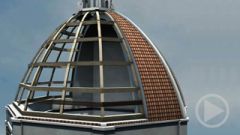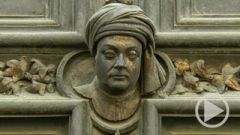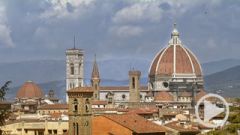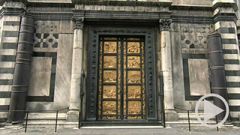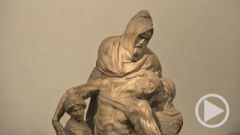- Home
- »
- Welcome
- »
- Italy
- »
- Florence
- »
- Florence Cathedral
- »
- Florence Cathedral - Finally a Facade
Finally a Facade
Finally a Façade
Leonardo, Michelangelo, Vasari
A generation after Filippo’s death, the lantern is crowned with a huge sphere of gilded bronze. It was the work of the sculptor Andrea Verrocchio. It’s probable that his apprentice helped out – a young man by the name of Leonardo, from the little town of Vinci. He’s particularly fascinated by Filippo’s machines, and studies them in detail.

Filippo’s work plays yet another, quite surprising role at the dawn of the Renaissance: The astronomer Paolo Toscanelli, who had once taught him mathematics, affixes a bronze plate to the inside of the lantern, converting the dome into a huge sundial. This enables him to determine the positions of the sun more precisely than ever before, thereby improving navigation. This in turn benefits one particular seafarer with whom Toscanelli corresponds regularly – a certain Christopher Columbus. So Filippo’s dome even makes a small contribution to the discovery of America.
In the year 1515, Baccio d'Agnolo is the Master Builder of the cathedral. He begins building a loggia at the base of the dome. But its proportions don’t quite fit. With biting sarcasm, Michelangelo calls it a “cricket cage” – and it’s never completed. But Michelangelo contributes more than just censure: his famous David was actually intended for the cathedral. And the Pietà created by the sculptor for his own grave graces one of the cathedral’s chapels for centuries.
Initially, the inside of the dome was simply painted white – and that remained the case for more than 100 years. Filippo himself had envisaged a mosaic design, like that of the baptistery. But in the year 1572, work began on a fresco for the dome – and the artist awarded the commission is none other than Giorgio Vasari. Filippo’s great admirer and biographer, now allowed to embellish the work of the man himself! The picture is hailed as the largest Christian fresco in the world.
Over a surface area of almost 4 thousand square metres, it does take up the subject of the images in the baptistery: the Last Judgement. The focal point is again Christ standing in judgement over the world, surrounded by angels. In the past, a sculpture of the body of Christ lay in the centre of the altar. This made the message of Christianity crystal clear: when the faithful raised their gaze from the dead Christ up towards the heavens, they beheld the resurrected saviour in all his glory. The graphic images at his feet bring home to them what they can expect in the future: the promise of paradise, or the horrors of hell.

From an artistic point of view, the work is considered slightly off the mark. The most serious criticism is that it makes the dome appear lower than it actually is – and not higher as intended. Nevertheless, the fresco is brimming with original ideas. For example, scaffolding installation holes double up as symbols of the wisdom of the written word: books offer an access to the realm behind the surface of our world.
But Vasari doesn’t live to realise his design – he dies after just two years. His successor is Federico Zuccari, who had previously worked mostly in Rome. He completes the huge work in the year 1579.
Eight years later, the exterior of the cathedral changes yet again: Francesco de' Medici has the half-finished façade by Arnolfo di Cambio removed. He actually plans to build a new one – but he doesn’t get around to it. That’s why for 300 years, the front of Florence cathedral is clad in nothing but brick, which the Florentines cover with large swathes of painted fabric.
Again and again, they haggle and fight over a new façade. But no progress is made until the 19th century, when Florence becomes part of the new Kingdom of Italy. In 1887, Emilio de Fabris finally completes the façade in its present form. He’s primarily inspired by Giotto’s belltower – and his design is chosen in yet another competition.

To this day, the cathedral is the spiritual heart of the city. It embodies the unique spirit of Florence. The cathedrals of the Middle Ages were filled with a mystical atmosphere, an expression of the hope of a better life in the afterworld. Florence cathedral, on the other hand, is filled with light, and faces the world head-on. Its greatest work of art is actually a brilliant feat of engineering – and the art works inside the building also celebrate illustrious people.
First the builders of the cathedral itself: Arnolfo di Cambio and Emilio de Fabris, Giotto and of course Filippo Brunelleschi. Alongside these portraits are two large frescoes: Paolo Uccello depicts Giovanni Acuto. His real name was John Hawkwood, he came from England and became a great military leader in the service of the Florentines. Next to him, Niccolò da Tolentino, painted by Andrea del Castagno. He was also a successful commander, who did the city a great service.
Faith itself has also changed. This is evident from two works of art that seem to embrace the faithful. Above the main portal, there’s a mosaic from the period of Arnolfo di Cambio. It shows Mary the Mother of God, being crowned by her son Jesus. Opposite her there’s a shining window high above the altar, the only “eye” of the tambour visible upon entering the church. It’s the work of Donatello – and it also depicts the crowning of Mary.
At the entrance, and at the heart of the church stands the mother of God. She was also revered in the Middle Ages – but now her message is being understood in a new way: Mary is a human being, chosen by God. People themselves are being given the power to change the world. And this belief was the inspiration for the immortal masters to whom we owe the cathedral itself and all its art treasures – the cathedral that celebrates the greatness of an imitable city, as well as the birth of a new epoch.


